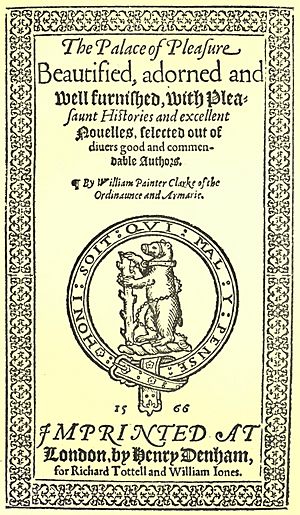William Painter (author) facts for kids
William Painter (sometimes spelled Paynter) was an English writer and translator who lived from about 1540 to 1595. He worked as a clerk for the Ordnance office in the Tower of London. During his time there, he faced questions about how he managed public money.
Contents
About William Painter's Life
For a long time, people thought William Painter was from Kent. This was because another person with the same name went to St John's College, Cambridge in 1554.
William Painter married Dorothy Bonham around 1565. They had at least five children: one son and four daughters. By 1587, his son Anthony started working with him in the government office.
Painter passed away in London between February 19 and 22, 1595. He was buried at St Olave Hart Street, a church not far from the Tower of London.
Painter's Work in Government
In 1561, Painter became a clerk for the Ordnance office in the Tower of London. He kept this job for the rest of his life. The Ordnance office was in charge of military supplies like weapons. In 1566, Edward Randolph, a high-ranking official, gave Painter extra money as a pension.
Throughout his career, there were concerns about how he handled money. People suggested he was using public funds for his own benefit. This became a big issue in 1586. John Powell, another official, accused Painter of mismanaging funds. Painter admitted he owed the government a large sum of money, over £1000. Even though he offered to pay it back, the debt was not fully settled until his grandson's time. This was due to delays during Painter's life and more issues found after he died. These accusations showed that there were often financial problems among government officials during the time of Queen Elizabeth I.
William Painter's Books
Painter started translating books into English in 1558. One of his first translations was a story called Horrible and Cruell Murder of Sultan Solyman. This story later became one of the tales in his most famous book.
The Palace of Pleasure
The first part of Painter's book, The Palace of Pleasure, came out in 1566. It was dedicated to the Earl of Warwick. This first book had 60 stories. A second part with 34 more stories was published the next year. In 1575, an updated version came out with seven new stories.
Painter gathered these stories from many different ancient and European writers. He used tales from Herodotus, Boccaccio, Plutarch, Livy, and many others. He also included stories from Italian writers like Matteo Bandello and Queen Marguerite de Navarre.
Influence on Plays
The Palace of Pleasure was very popular. It helped start a trend in English plays where stories were set in Italy. Many famous plays from that time used ideas from Painter's book.
For example, early tragedies like Appius and Virginia and Tancred and Gismund were based on stories from The Palace of Pleasure. Even Shakespeare used Painter's work! Some of Shakespeare's plays, like Romeo and Juliet, Timon of Athens, Edward III, and All's Well That Ends Well, got their ideas from Painter's translations. All's Well That Ends Well came from Painter's translation of a story called Giletta of Narbonne. Other playwrights also used stories from Painter and similar translators for their plays.
Later Editions
In 1813, a new edition of The Palace of Pleasure was put together by Joseph Haslewood. Later, in 1890, Joseph Jacobs compared this edition to an older copy from 1575. Jacobs also wrote more about how important Italian stories were to plays during Queen Elizabeth's time.
Some people think Painter might have also written a poem in 1580 called A Moorning Diti upon the Deceas of the High and Mighti Prins Henri, Earl of Arundel.
Other People Named William Painter
It's important to know that there were other people named William Painter living at the same time. One William Painter went to Cambridge University from 1554 to 1557. He might be the same person who was a schoolmaster at Sevenoaks School in Kent. This schoolmaster translated a book called Antiprognosticon in 1560. He died in Sevenoaks in June 1561. There were also other William Painters who were priests in different parts of England. Another William Painter died in London around 1597.


